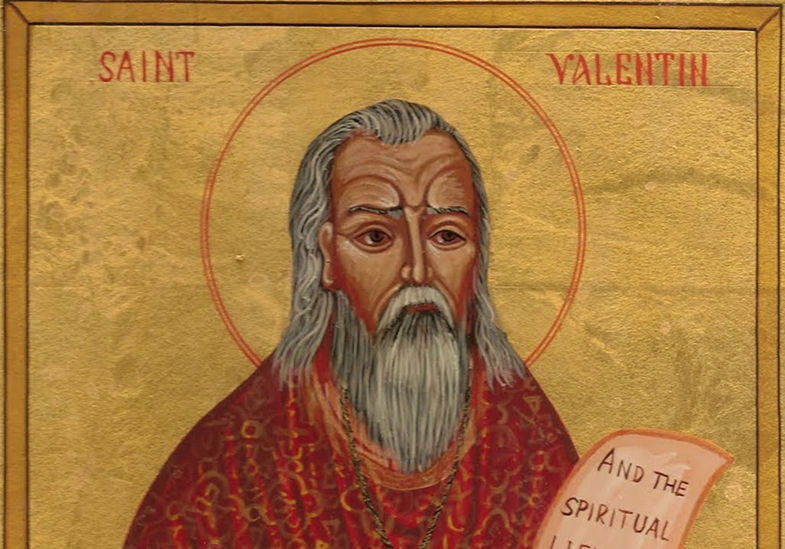Valentine’s Day
Pagan, Christian, Folkloric, Commercial.
On Tuesday, February 14, much of the world, Christian and otherwise, celebrates Valentine’s Day. But what is the story behind this much observed day? The origin of this date is uncertain: It seems to be linked to the pagan tradition of the feast of the Lupercalia, a Roman spring ceremony. On February 14, the sacred marriage between Zeus and Hera took place in Athena, as well as the Roman festival in honor of the fertility god, Lupercus.
February 13 was the day dedicated to peace, harmony, love, and family. The priests of Lupercus performed a purification ritual involving the sacrifice of goats and the consumption of wine. After the ritual, the priests would go to the streets of Rome with the goatskins touching anyone whom they encountered. Young women took advantage of the opportunity because it was said that by touching the goatskins, they could improve their chances of giving birth to a child. During Lupercalia, girls’ names were collected in boxes and boys extracted them. Then the boys would pair up with the girls whose names they had selected. The pairing was to last all year, but most of the time, the result was just a physical relationship.
At another place and time, this day was long ago called Birds’ Wedding Day, mainly by people from the Nordic countries and the British Isles because people imagined that birds chose their mate exactly on February 14.
But what of the well-known Saint Valentine? Information about his life is conflated with the legend. The biographic sources Martyrologium Hieronymianum (5th–6th century A.D.) and Passio Sancti Valentini (8th century A.D.) seem to convey the existence of two saints named Valentine, with the first being a martyr from Rome, and the second being a martyr from Terni. But in recent years, a new hypothesis has been adopted by the scholar Vincenzo Fiocchi Nicolai, which proposes that Valentine from Terni and Valentine from Rome were the same person. Therefore, there was only one Valentinus, Bishop of Terni, who arrived in Rome in 270 A.D. during the Christian persecution by the Roman emperor Claudius II; there he was killed and buried.
Valentine was called to Rome by the orator Craton because news of the saint’s work had spread throughout the capital. Craton was impressed with Valentine’s sanctity, charity, and apostolate. He hoped Valentine could heal his son, who had been ill for several years. After the young man was healed, Valentine converted Craton’s family to Christianity.

In fact, tradition says that the saint united in marriage a Christian girl named Serapia and a Roman centurion. This act contravened Claudius’ edict, which forbade marriage between legionaries and women who belonged to the Christian faith. Due to these events, Valentine was imprisoned and sentenced to be beheaded on February 14, 273 A.D. It is said that his remains were buried 63 Roman miles from Rome on Via Flaminia, the ancient road leading to Terni (Italy).
February 14, as a feast day, was established by Pope Gelasius I in 496 A.D. There is disagreement amongst historians about whether the holiday was meant to replace the pagan fertility festival Lupercalia. Either way, as time passed, more romantic connotations came to be associated with the saint. Over time, the holiday and Christian significance were replaced by Valentine’s Day, which has as its spiritual patron Cupid, the god of love, which essentially generated the commercial side of the holiday.
The man famous for supposedly sending the first Valentine’s Day card was a 21-year-old Frenchman Charles, Duke of Orleans, who was imprisoned in the Tower of London after having been captured during the Battle of Agincourt (1415). He sent a poem titled “Farewell to Love” to his 16-year-old wife, Bonne of Armagnac.
In Europe
Dydd Santes Dwynwen is considered to be the Welsh equivalent to Valentine’s Day and is celebrated on January 25 every year. In the 1960s, as the commercialization of St. Valentine’s Day continued apace, the first St. Dwynwen’s Day cards were produced in Wales. St. Dwynwen’s Day is in part a protest against the globalizing commercialization of St. Valentine’s Day. But it is also an attempt to find a place in the same marketplace for a distinctively Welsh product.
The holiday has been celebrated in Britain since the 17th century. The most valued Valentine’s Day gifts are handmade pastries and sweets. British tradition includes the baking of a cake in the shape of a heart, which is given to a loved one.
In France, a traditionally Catholic country, Valentine’s Day was traditionally observed with une loterie d’amour in which single people stood in front of houses calling out other singles. They eventually paired off for the evening. After the practice got out of hand and was banned by the French government, sending greetings became popular. Today, French Valentine’s Day revolves around gift-giving, as is common in many Western countries.
In Denmark and Norway, Valentine’s Day is not celebrated on a large scale, but many people take the time to spend some romantic time with their life partner or send a greeting card to a secret love. In Sweden, February 14 is called “All Hearts Day,” but it is not an official holiday.
In Finland and Estonia, Valentine’s Day is a celebration of friendship rather than love. In fact, February 14 is “Friends’ Day,” a day when people usually give greeting cards and small gifts to friends. The streets are decorated with hearts, but the holiday emphasizes love for friends and family. However, February 14 is a suitable day for getting engaged in these two countries as well.
In Slovenia, a proverb says that Valentine’s Day brings the keys that unlock plant roots, so on February 14, plants and flowers begin to grow. Valentine’s Day was celebrated as the day when work began in the vineyards and fields. It is also said that birds get married on this day. Certainly, it is only recently that it began to be celebrated as “Love Day.” “Love Day” was traditionally March 12, St. Gregory’s Day.
In Romania, the traditional holiday for lovers is Dragobete, which is celebrated on February 24. The name comes from a character in Romanian folklore who is supposed to be the son of an old woman called Dochia. Etymologically, part of the name Dragobete can also be found in the Romanian word for “love,” dragoste. Romania has also started to celebrate Valentine’s Day, although it already had its own traditional holiday in Dragobete. These days, all Romanians are familiar with Valentine’s Day, but very few know about Dragobete.

In the Middle East and Africa
In Turkey, Valentine’s Day has become popular in the last 15 to 20 years due to the rising consumption economy. Malls and shops are decorated, roses and chocolates are sold, and restaurants and nightclubs are visited. Its traditional lovers’ day is St. Gregory’s Day.
In Persian culture (Iran), the day dedicated to love takes place on February 17. It was celebrated in the Great Persian Empire as early as the 20th century B.C. In Egypt, there is another holiday on the 4th called the “Day of Egyptian Love.”
The people of Ghana have adopted many Western traditions similar to Valentine’s Day. However, since 2007, February 14 has been declared “National Chocolate Day,” which is fitting given that Ghana is one of the largest exporters of chocolate in the world. The decision was made by the Ghana Ministry of Tourism out of a desire to promote the state’s contribution to global chocolate production and to attract foreign tourists to West Africa – both commercial considerations.
In North and South America
People in the United States most likely began exchanging greetings on this holiday around 1700. In the 1840s, Esther A. Howland began selling the first greeting cards in America. Known as the “Mother of the Valentine,” she made elaborate greeting cards out of silk, ribbons, and colorful images.
Currently, according to the Greeting Card Association, approximately one billion greeting cards are sent globally each year on Valentine’s Day. This makes Valentine’s Day the second busiest holiday of the year (following Christmas) in terms of the number of greeting cards sold.
In Brazil, Valentine’s Day (or Día de los Novios) is celebrated on June 12. Couples give each other gifts such as chocolate, greeting cards, and usually a bouquet of flowers. It was chosen as the day before Saint Anthony’s Day, known there as the saint of marriage, when many single women perform folk rituals to find a good and loving husband. In Brazil, February 14 is not used, as this date is too close to another holiday called Carnival.
Mexico celebrates Valentine’s Day (or El Dia del Amor y la Amistad) on February 14. As in many other countries, it is celebrated with balloons, flowers – particularly roses – and other gifts to express one’s love. Many couples go out for dinner to make the most of a romantic evening.
In Colombia, Día de Amor y Amistad (Day of Love and Friendship) is celebrated on the third Saturday of September. This is essentially the Valentine’s Day of Colombia. In this country, the “secret friend” is a very popular tradition, which involves designating each participant as a recipient of a secret gift.
In the Far East
Thanks to a focused marketing effort, Valentine’s Day has also appeared in Japan and Korea.
In Japan, girls give chocolates to the boys they like, as well as to their friends on this day. But not all chocolates are created equal. There are two types of chocolate that the women give. One is called giri-choco that are quick ready-made chocolates that you give to friends and family, or people that you love in a non-romantic way. Giri means obligation, so these chocolates are more of an obligatory gift for loved ones to show that you care. The other kind are honmei-choco. Honmei-choco are given to the guys that girls are truly romantically interested in, or their romantic partners. These chocolates are usually either fancier, more expensive, or homemade.
Valentine’s Day in Korea is a bit different from Valentine’s Day elsewhere in the world. In fact, Valentine’s Day has now become just one of 12 “love days” celebrated on the 14th of every month in Korea. These days range from the popular (White Day, March 14) and depressing (Black Day, April 14), to the bizarre (Hug Day, December 14) and everything in between. A lot of money is both spent and made on Valentine’s Day and White Day, while the other love days receive little commercial attention.
On White Day in both South Korea and Japan, the men are expected to return the favor to those who gave them chocolates on Valentine’s Day. In the past, the return gift was a meringue or white chocolate in Japan and white candy in Korea, hence the name White Day. But now lingerie has also become a very common gift.

The Chinese also celebrate Valentine’s Day on February 14. In addition, China has its own version of Valentine’s Day, which is celebrated as three festivals (Lantern Festival, Shangsi Festival, and Qixi Festival).
Perhaps the most romantic and endearing of Chinese lovers’ traditions is the Qixi, or Double Seven Festival, that has been celebrated since the Zhou Dynasty (1046–256 B.C.). Qixi is celebrated on the seventh day of the seventh lunar month, which is in August of the Gregorian calendar. This day is known as Chilseok in Korea.
Legend has it that a god and a goddess fell in love against the wishes of the Jade Emperor and the Heavenly Queen Mother. It is a love story between Zhinü (a weaver girl, symbolizing the star Vega) and Niulang (a cowherd, symbolizing the star Altair). Their love was not allowed, so they were banished to opposite sides of the Silver River (symbolizing the Milky Way). Zhinü fell in love with Niulang, and they got married without the knowledge of the Heavenly Queen Mother. Niulang and Zhinü lived a happy life together. Niulang worked in the fields while Zhinü did weaving at home. As the years passed, they had two children, one boy and one girl. As with many legends, there are many variations of this story. Niulang and Zhinü are known as Jik-nyeo and Gyeon-u in the Korean version of this love story.
Red hearts, pink bows, candies wrapped in purple, angels hanging between fluffy and blue clouds, love statements, and other “sweet and cute” events are just some of the elements of modern Valentine’s Day. Every February, on the 14th, Valentine’s Day is celebrated with great pomp, and the “holiday” has become a very clear landmark on the twisted map of consumer habits, borne of pagan beliefs, Christian virtue, and legendary lure.
Compiled by Melline Galani.
Resources:
CrestinOrtodox.ro. (2012, February 2). Sfantul Valentin: Sarbatoarea Roz. https://www.crestinortodox.ro/reportaj/sfantul-valentin- sarbatoarea-roz-72309.html
Critic Arad. (2020, February 14). Sfantul Valentin. https://criticarad. ro/sfantul-valentin-intre-semnificatii-crestine-legende-populare-si -implant-comercial/
Evans, L. (n.d.). Saints of Terni. Key to Umbria http://www. keytoumbria.com/Terni/St_Valentine.html
Ketchell, M. (2017, January 5). How St. Dwynwen wrongly became known as the Welsh Valentine. The Conversation. https://the conversation.com/how-st-dwynwen-wrongly-became-known-as- the-welsh-valentine-71520
Scapin, L. (2013, February 14). The message of St. Valentine is in the power of love. Episcopia Romano-Catolica de Iasi. http://ercis.ro/ actualitate/viata201302.asp?id=20130258
Travel China Guide. (2020, June 23). How many Valentine’s Days are there in China? Amazingly three! https://www.travelchinaguide. com/essential/holidays/chinese-valentines-day.htm
Umoh, V. (2019, February 13). A day with Saint Valentine of Rome: Patron of young couples. Vu Biblia Academia. https:// valentineumoh.com/2019/02/13/a-day-with-saint-valentine-of- rome-patron-of-young-couples/



